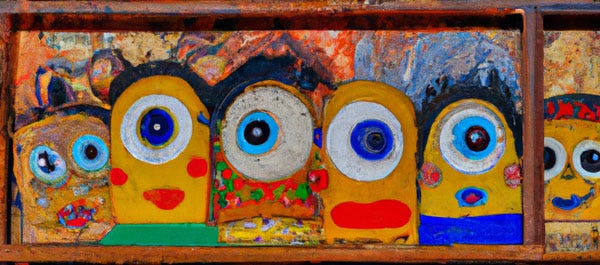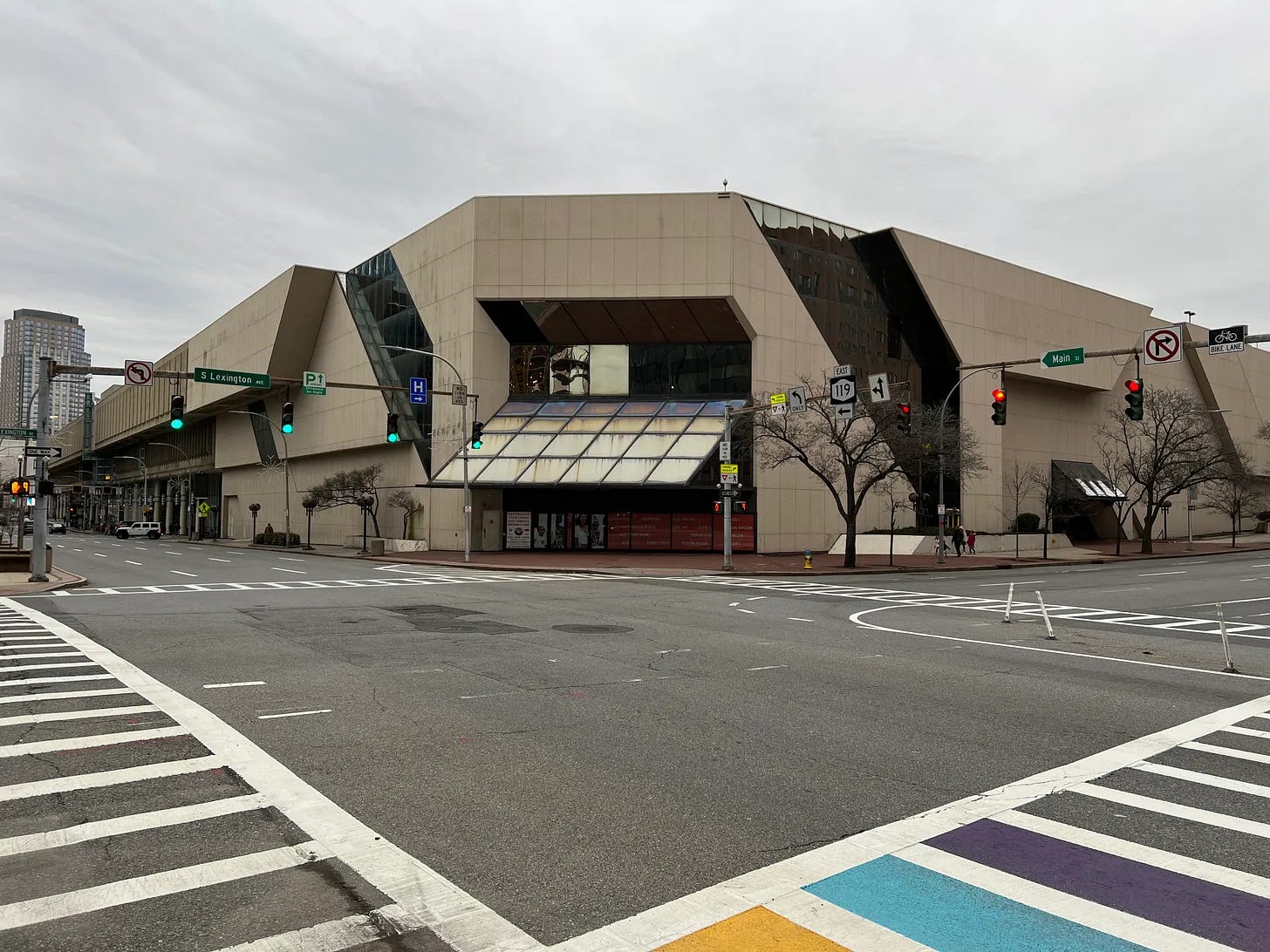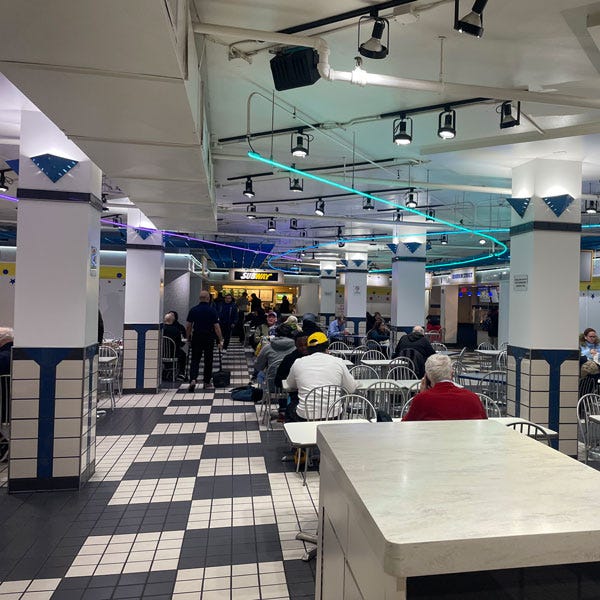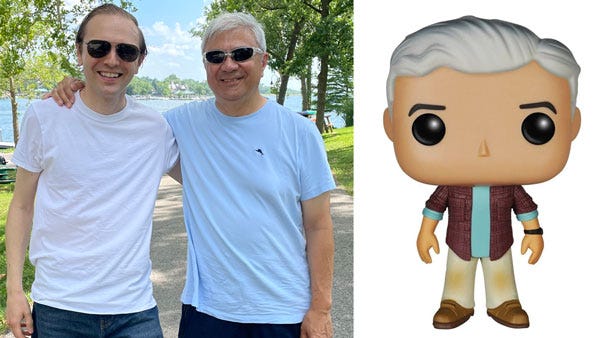Wednesday Walk: Mall Walking
A mall closes, a retro foodcourt, and $30 million worth of discarded plastic figurines
Welcome to Willoughby Hills!
As is typical every Wednesday, today I’m bring you a smattering of topics that I hope will make you a bit more curious about the world around you and give you something to think about later.
If you enjoy what you’re reading, please consider a free subscribtion to receive emails every Wednesday and Sunday plus podcast episodes every two weeks. There are also paid options, which unlock even more features.
Adieu to the Mall
Ever since interviewing Alexandra Lange on the podcast about her book Meet Me By the Fountain, I’ve been thinking a lot about shopping malls. One observation that Alexandra shared in her book is that everybody has their mall and the memories of that mall can be very personal.
With that in mind, I really enjoyed reading Rolando Pujol’s recent piece for The Retrologist about the closure of The Galleria in White Plains, NY. If you’re not already reading his work, you should be! Rolando documents the current state of roadside America, but this piece about The Galleria was especially personal because he’s describing the demise of his own childhood mall.
The mall opened in 1980, replacing two city blocks worth of small shops with a Brutalist concrete and glass facade. I’m generally not a fan of Brutalism, but there is an odd beauty in this old mall.
The Galleria was to be the centerpiece of an urban renewal project in White Plains, and its construction displaced many mom and pop shops. Rolando included a view of the same street in 1968 and today, and the difference is stark. It’s also quite the visual reference for what malls did across the country- taking the public street life off the sidewalk, moving it under a roof, and privatizing the experience.

Rolando predicts that The Galleria could become a mixed use area again, combining shopping, dining, housing, and office space in a distinctly twenty-first century way that is also rooted in the design of our neighborhoods and villages going back hundreds of years.
I can understand Rolando’s sadness about the closing of his childhood mall, but I think back to this passage from Alexandra Lange’s book (which she touched on in our conversation on the podcast too) about the opportunity that might arise from dead malls:
“Given the prevalence of ruin porn, it is easy to imagine many malls going ‘back to nature’: cracks in the tarmac, cracks in the quarry tile, the plants in the fern bar gone feral, the potted trees bursting through the glass ceiling of the atrium. But beyond postapocalyptic fantasy is the germ, literally, of economic growth. Malls are reservoirs of open space in increasingly built-up environments, both within their walls and outside in their oversize parking lots. Where else could a city, or a suburb, ‘find’ over one hundred thousand square feet of available space for a new public library? Where else could they ‘find’ a new park location close to existing housing, displacing no one, and with minimal demolition required? Postwar public policy created the need for the mall in the spaces between subsidized single-family homes and subsidized roadways, with single-use zoning serving as the barrier between each of these uses. Today, those barriers are crumbling, as changing patterns of work and home life mix commercial, industrial, and residential in ways niever imagined by developers. The defunct mall becomes an opportunity to knit suburbs back together, via a retrofit that suits reality rather than a long ago vision of (white) women in the suburbs and their husbands in the city. The mall is neither a joke nor a den of zombies, but a resource.”
If you’re interested in reading more, check out Rolando Pujol’s issue on The Galleria and subscribe to The Retrologist while you’re there!
And apropos of nothing, I came across this amazing retro food court in the middle of Boston’s Downtown Crossing this week. It was once part of a complex called The Corner Mall, although nearly all the shopping inside is now vacant and the second floor is closed to access.
I visited here on occasion as a student at Emerson College (it was the closest place a suburban kid could get his fix for mall food like Sakkio/Sarku Japan’s chicken teriyaki), but that was almost 20 years ago. I stopped in this week and it felt like stepping onto the set of Saved by the Bell. Here’s a few photos:
Buried Bobbles

If you’ve been into a toy store, record store, comic book store, or practically any other kind of store over the past several years, you’ve probably come across a giant wall of Funko Pop figures. For the uninitiated, they are PVC toys that kind of resemble a bobble head, but without the bobble. They all have big heads, small bodies, the same distinct eyes, and they usually resemble pop culture icons.
According to a Rolling Stone profile in 2014, Funko Pop figures were all the rage at one time:
“Pick a hot franchise, and there’s a good chance Funko has either secured the rights to its signature characters or is currently doing so. Star Wars, Star Trek, Ghostbusters, Game of Thrones, The Walking Dead, The Big Bang Theory, the Disney canon, musicians from Kiss and the Ramones to Run DMC and Tupac, World of Warcraft, WWE, MLB and the NBA: these are only a handful of the properties Funko has in play.”
Back then, the inexpensive plastic toys were a huge moneymaker for the company:
‘We were in the $40 million range for revenue last year — and $28 million of that was from Pop figures alone,’ [CEO Brian] Mariotti says.”
Fast forward to 2023, and according to Kotaku, the company is destroying $30 million worth of inventory so that the cost of these figures can be written off:
“Funko’s warehouses are overflowing… and throwing them out will be cheaper than trying to sell them. During a call with investors, CEO Brian Mariotti said a new distribution center in Arizona was so full that the company has been bleeding cash renting shipping containers to hold all of the excess inventory.”
They have so many that it’s cheaper to destroy them than to attempt to distribute them, even at a steep discount. Several million figures will simply be buried in a landfill, and because they’re PVC, they’ll just kind of sit there for thousands of years.
I’ve always gotten a little grin out of the Funko Pop figures when I’ve seen them in the store, although it wasn’t enough to motivate me to bring many home.
We have maybe four or five Funko Pop figures in our house that belong to our kids. The one that comes to mind immediately is from the long-forgotten 2015 film Tomorrowland. There was a George Clooney figure made to promote that movie, but it didn’t sell well and eventually made its way to my local Disney Store Outlet.
It didn’t really look like George Clooney, but I thought it kind of resembled my dad. As I recall, it was about $1.99 so I couldn’t resist buying it. My kids still refer to that as “the Grandpa Joe toy.”
Pretty much every TV show, movie, video game, cartoon character, corporate logo, athlete, and Disney theme park ride that you can imagine has been immortalized in the Funko treatment. There are literally thousands of these figures available, and according to Kotaku, they aren’t really as collectible as they may seem:
“Over the long run, 99 percent of Funkos are worthless outside of whatever depraved joy fans get from occasionally making eye contact with the ones lining their shelves.”
So we buy a bunch of plastic toys that hold no residual value. The ones we don’t buy end up getting shipped to a landfill. To quote Timon in The Lion King: “And everybody’s okay with this?”
It all brings to mind a book that I recently borrowed from my library after Sarah Susanka mentioned it in The Not So Big Life (and listen to my interview with Sarah if you haven’t heard it yet).
The book is called Material World: A Global Family Portrait by Peter Menzel. It features portraits of families in many parts of the world, photographed outside of their homes surrounded by all of their possessions.
It is jarring to see families in Africa who seem to live a happy existence surrounded by a few cooking utensils, storage baskets, and tools, while we toss millions of plastic toys into a landfill or clothing brands burn their inventory rather than discount it, in part to maintain an air of exclusivity.
Our world has a lot of stuff in it, with more of it containing plastic than ever before. I’m intrigued by the story of Funko dumping a bunch of product, but also wonder what we can do to keep overconsumption from destroying us and the world around us.
Shoutouts
This is a new feature in the newsletter, but I have so many friends and colleagues doing cool things that I wanted to find a quick place to put them on your radar!
Jesse Terry, who I interviewed in 2021 has a new children’s book out. If I Were the Moon is based on a song he wrote for his young daughter. It’s beautifully illustrated by Jacqueline East. Go check it out!
My friend Denise Sfraga has an exhibit of her art running at Garage Art Center in Queens all month. Denise was a photo editor at This Old House magazine for many years and she’s also a beautiful abstract painter. The venue is a garage that has been converted into an art gallery- adaptive reuse! If you’re in New York, go check out her show or give her a follow on Instagram!
If you have an item that you’d like me to include in a future Shoutout, please send it my way! I love hearing what you’re all up to and it’s sometimes hard for me to keep track on my own.
Thank you for reading! Did you get something out of today’s issue? I always love hearing your thoughts, so please drop a line in the comments.
I publish new issues every Wednesday and Sunday. Sign up to always receive the latest issue and support my work:
Other Wednesday Walks
Please consider sharing this with a friend that you think might enjoy it or you can post it on social media.
If you’ve missed past issues of this newsletter, they are available to read here.
Stay Safe!
Heath












Are you familiar with Mount Trashmore in Virginia Beach? Maybe there could be several Mount Funkos. In the meantime, this is another sounding siren to decrease the use of plastic whenever and whatever small ways are possible in our daily lives.
Great writeup!